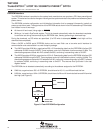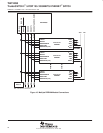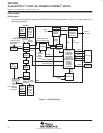
TNETX4090
ThunderSWITCH II
9-PORT 100-/1000-MBIT/S ETHERNET
SWITCH
SPWS044E – DECEMBER 1997 – REVISED AUGUST 1999
42
POST OFFICE BOX 655303 • DALLAS, TEXAS 75265
EEPROM interface
The EEPROM interface is provided so the system-level manufacturer can produce a CPU-less preconfigured
system. This also can be used to change or reconfigure the system and retain the preferences between system
power downs.
The EEPROM contains configuration and initialization information that is accessed infrequently, typically at
power up and after a reset. The organization of the EEPROM data is shown in the DIO address map. Downloads
are initiated in one of two ways:
At the end of hard reset (rising edge on RESET)
Writing a 1 to load in SysControl register. This bit is cleared automatically when the download completes.
It cannot be set during the download by the EEPROM data, thereby preventing a download loop.
During the download, no DIO writes are permitted. (If a DIO write is attempted, SRDY is held high until the
download has completed.)
Either a 24C02 or 24C08 serial EEPROM device can be used. Both use a two-wire serial interface for
communication and are available in a small-footprint package.
The 24C02 provides 2048 bits, organized as 256 × 8. Downloading data from the EEPROM initializes DIO
addresses 0x0000 through 0x00FB. These registers control all initializable functions except VLANs. The
downloading sequence starts with DIO address 0x0000, continuing in ascending order to 0x00FF.
The 24C08 provides 8192 bits, organized as 1024 × 8. Downloading data from the EEPROM initializes DIO
addresses 0x0000 through 0x03FF. These registers control all initializable functions, including VLANs. The
downloading sequence starts with DIO address 0x0100, continuing in ascending order to 0x03FF, followed
by address 0x0000, continuing in ascending order to 0x00FF. This ensures that SysControl is the last
register loaded.
The EEPROM size is detected automatically according to the address assigned to the EEPROM:
2048 bits, organized as a 256 × 8 EEPROM, should have its A0, A1, and A2 terminals tied low.
8192 bits, organized as a 1024 × 8 EEPROM, should have its A0 and A1 terminals tied low and A2 terminal
tied high (see Figure 9).
24C0x
Flash EEPROM
A0 A1 A2
GND
24C02: GND
24C08: V
DD
SCL SDA
EDIO
ECLK
TNETX4090
Figure 9. Flash EEPROM Configuration


















